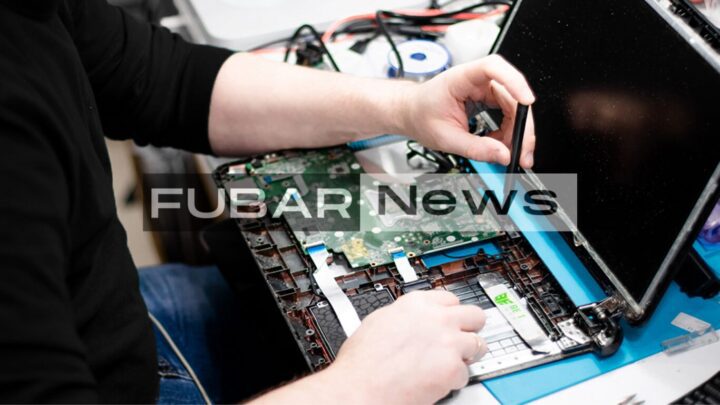Is your laptop acting up again? Nothing can be more frustrating than a malfunctioning device when you need it the most. But before you start panicking and rushing to the nearest repair shop, take a deep breath. Sometimes, all it takes is a little troubleshooting to get your laptop back in working order. In this blog post, we will guide you through five simple steps to fix common issues with your laptop. Whether it’s a power supply problem or an overheating issue, we’ve got you covered! So grab your toolkit and let’s dive into the world of laptop repair London!
Step One: Check the Power Supply
One of the most common issues that can cause a laptop to not turn on or display any signs of life is a problem with the power supply. Before jumping to conclusions and assuming your laptop is broken beyond repair, it’s important to check this crucial component.
Make sure that your laptop is properly connected to a working power source. It may seem obvious, but sometimes a loose connection or a faulty power outlet can be the culprit behind your laptop woes. Try plugging in another device into the same outlet to see if it works.
If you’re using an external power adapter, double-check that all cables are securely plugged in both at the outlet and into your laptop. Sometimes these connections can become loose over time, especially if you frequently move your laptop around.
Next, examine the power cord for any visible damage such as frayed wires or bent connectors. If you notice any issues here, it’s best to replace the cord immediately as using damaged cords can pose risks not only to your laptop but also personal safety.
In some cases, laptops have removable batteries which could be causing problems. Remove the battery completely from its compartment and try turning on your laptop while it’s connected directly to an AC adapter. If it powers up without any issues, then you may need to replace your battery.
Step Two: Check for Overheating
One of the common issues that can cause a laptop to malfunction is overheating. When a laptop gets too hot, it can lead to performance problems and even hardware damage. That’s why it’s important to regularly check your laptop for signs of overheating.
The first thing you should do is make sure that your laptop is properly ventilated. Check if any vents or fans are blocked by dust or debris, as this can obstruct airflow and contribute to overheating. Use compressed air or a soft brush to clean out any accumulated dirt in these areas.
Another way to prevent overheating is by using a cooling pad or stand. These accessories provide additional airflow and help dissipate the heat generated by your laptop’s components.
It’s also worth checking if you’re running resource-intensive programs or tasks that may be causing your laptop to work harder than usual, leading to increased heat production. Consider closing unnecessary applications or reducing the workload on your computer when it starts getting too hot.
Step Three: Check the Battery
One of the most common issues that can cause laptop problems is a faulty battery. If your laptop suddenly shuts off or won’t turn on at all, it could be a sign that the battery needs to be replaced.
Start by unplugging your laptop from its power source and removing the battery. Check the battery for signs of damage, such as bulging or leakage. If you notice any abnormalities, it’s time to get a new one.
If there are no visible signs of damage, try cleaning the contacts on both the battery and inside your laptop with rubbing alcohol and a cotton swab. Sometimes dirt or debris can interfere with proper contact and cause issues.
After cleaning, reinsert the battery into your laptop and plug it back in. Allow it to charge fully before turning on your device again. If this resolves the issue, then congratulations! You’ve successfully fixed your laptop without having to spend money on a new battery.
Step Four: Run a Diagnostic Test
When your laptop is acting up and you’ve ruled out power supply issues, overheating, and battery problems, it’s time to dig deeper and run a diagnostic test. This step can help identify any underlying hardware or software issues that may be causing the malfunction.
To begin the diagnostic process, you’ll need to access the built-in diagnostics tool on your laptop. The exact method varies depending on the brand and model of your device, so consult the user manual or do a quick online search for instructions specific to your laptop.
Once you’ve accessed the diagnostics tool, follow the prompts to start scanning for potential errors. The tool will check various components such as the hard drive, memory modules, graphics card, and CPU for any anomalies or failures.
During this process, it’s important to pay attention to any error codes or messages that are displayed. These can provide valuable clues about what might be wrong with your laptop. If you’re unsure about what an error code means or how to address it, don’t hesitate to seek assistance from a professional technician.
After completing the diagnostic test and obtaining any necessary information about potential issues with your laptop’s hardware or software, you can decide whether further troubleshooting steps are needed. Depending on the severity of the problem discovered during testing, you may need to consider contacting technical support or taking your laptop in for professional repair.
Step Five: Reset Your Laptop
If you’ve tried all the previous steps and your laptop is still not functioning properly, it may be time to consider resetting it. Resetting your laptop can help resolve software issues and restore it to its default settings. Follow these simple steps:
1. Backup your data: Before proceeding with a reset, make sure to back up any important files or documents that you don’t want to lose. You can save them on an external hard drive or cloud storage.
2. Access the recovery options: Depending on the manufacturer of your laptop, there are different ways to access the recovery options. It could be through a specific key combination during startup or via the operating system’s settings menu.
3. Choose the reset option: Once you have accessed the recovery options, look for the option that allows you to reset your laptop. There may be a button that says “Reset this PC” or something similar to that.
4. Follow the prompts: When you initiate the reset process, your laptop will guide you through a series of prompts and warnings before proceeding with resetting itself.
5. Wait for completion: The duration of the reset process will depend on various factors such as your laptop’s specifications and amount of data stored on it.
Remember that resetting your laptop will erase all personal files and installed applications, so ensure that everything important is backed up beforehand.
Conclusion
Repairing a laptop may seem like a daunting task, but with the right steps and some troubleshooting, you can often fix common issues on your own. By following these five steps to fix a laptop, you can save yourself time and money by avoiding unnecessary trips to the repair shop.
Remember to start by checking the power supply and ensuring that it is properly connected. Next, address any overheating issues by cleaning out dust or investing in a cooling pad. If your laptop’s battery is not holding a charge, consider replacing it. Running diagnostic tests can help identify software or hardware problems, allowing you to find appropriate solutions. And finally, if all else fails, resetting your laptop can sometimes resolve stubborn issues.


